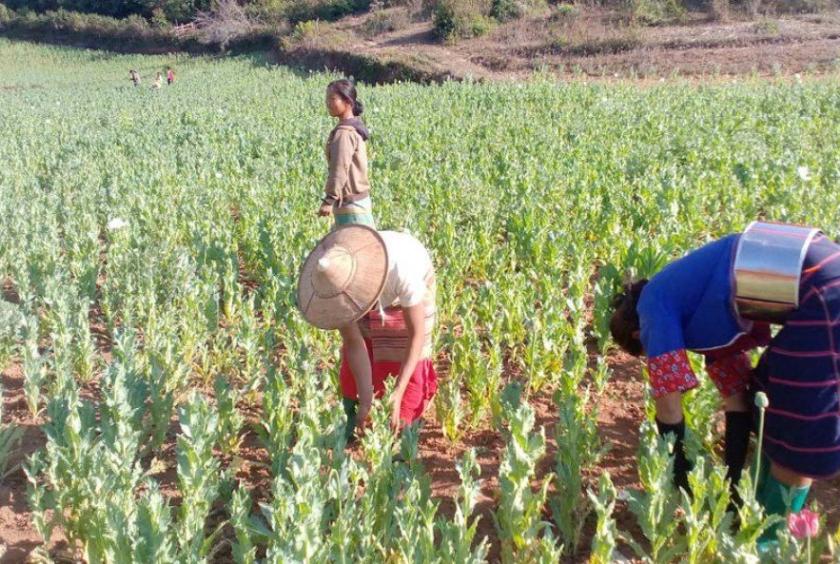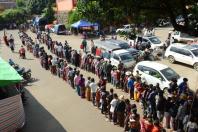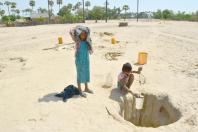
A United Nations report released on December 12, 2023 stated that due to internal instability and the decline of opium cultivation in Afghanistan, Myanmar has become the world's largest opium-growing country.
A 95 percent drop in opium cultivation in Afghanistan since the Taliban banned the drug in 2022 has shifted global opium supply to Myanmar, according to a report by the United Nations Office on Drugs and Crime (UNODC).
It is said that after the military takeover in Myanmar in 2021, the politics, social and economic instability in Myanmar caused most of the farmers in Myanmar to grow poppy.
It is reported that Myanmar farmers now receive about 75 percent of their income from poppy cultivation.
The average price of opium is US$355 per kilogram. The cultivated area is said to have increased by 18 percent year-on-year, from 40,100 hectares to 47,000 hectares.
As a result, opium production reached its highest level since 2001, according to UNODC.
"After the political change in 2021, farmers in remote areas continue to grow opium to earn income due to the instability in economy, security and administration sectors," UNODC said.
■ Country that produces and distributes large amounts of ecstasy, including amphetamine
In place of heroin and opium, methamphetamines such as amphetamine have replaced and are being widely traded everywhere, causing concern for the world's drug control.
Information says that many methamphetamines are being imported, produced and distributed in the Golden Triangle region, including Myanmar.
According to data surveys in the world, including UNODC, Myanmar is one of the top countries in the production of ecstasy such as amphetamine.
It is reported that 50 percent or more of the money from drug trafficking out of Myanmar comes from amphetamine.
In the Golden Triangle region, the production and distribution of drugs such as amphetamine is not decreasing every year but increasing.
The Thai authorities announced that in December 2023, a record amount of more than 50 million methamphetamine ecstasy pills illegally imported from Myanmar was seized in the Kanchanaburi Province of western Thailand, which is adjacent to the Myanmar border. This is the largest amount of methamphetamine seized in Thailand.
UNODC's South East Asia representative, Jeremy Douglas, said that there was no incident like this in the Kanchanaburi area.
Regarding this, he said that it is not surprising that the arrests were made because methamphetamine is being produced on a large scale by armed groups and drug dealers in northern Myanmar and the border areas bordering the Thai border.
In Myanmar, the production and distribution of large quantities of amphetamine, methamphetamine, WY, and Ecstasy pills is a worrying situation for the world's anti-drugs campaign.
■ Narcotics drugs: a growing substance in Myanmar
The report by ISP issued on September 15, 2023 said that widespread availability of various illicit substances, including marijuana, different types of tablets, ketamine, and ice, particularly among the youths in many townships. In 93 of those 110 townships surveyed, several kinds of illicit substances were found to be easily accessible.
The study shows that in Muse, and some townships, there are more than 100 points of contact where drugs are available. The situation in Kengtong Township is particularly alarming with at least 250 locations for accessing drugs.
According to a survey’s result, in 94 of those 110 townships surveyed (85 percent), marijuana was the most widely-used substance. Following closely were Ya Ba (or WY) and Ecstasy (E), while glue sniffing ranks as the third most common form of drug abuse. Many young people also use cocaine, various forms of methamphetamine, and ketamine, according to ISP.
The report also highlighted that there has been an increase in the opium cultivation and similarly, it also pointed out that the SAC has weakened in cutting its anti-drug efforts. As the armed conflict has widened, law enforcement officials have lacked the capacity to intercept drug trafficking, and the illicit trade has grown along with the war economy. Illicit drugs have now become cheap and easily accessible.
By looking at the ISP report, it was found out that the lack of rule of law and order and increase in armed conflicts, led to increase accessibility in the use of drugs.
According to the SAC’s data on destroyed seized substances, the government destroyed US$301 million worth of substances in 2019, US$839 million worth of substances in 2020, US$667 million worth of substances in 2021, US$642 million worth of substances in 2022, and US$446 million worth of substances in 2023.
■ Connection between armed groups and the drugs
Senior General Min Aung Hlaing in his speech at the National Defense and Security Council meeting held on January 31, 2024, he elaborated the connection between armed groups and the drugs.
It was found that the insurgent and terrorist groups are instigating instabilities and taking advantage of the situation, they are carrying out drug trafficking. As drug trafficking encourages money laundering, arm smuggling and terrorism, it is a challenge to stability in the country. As chemicals and precursor materials used in manufacturing narcotic drugs can be produced in the country, the insurgents are smuggling them into the country through various ways and means, said Senior-General Min Aung Hlaing.
In connection with the seizure of chemical and precursor materials, during the six-month period from 1 August 2023 to 29 January 2024, 3,272 cases of drug smuggling including seizure of 1.1 ton of heroin, over 117 million stimulant tablets and more than 14.665 tons of ice worth Ks-781.02 billion were uncovered and 4,373 males and females were arrested.
During the period from 1 February 2021 to 29 January, 2024, more than 6.05 tons of heroin and more than 629 million of stimulant tablets and 53 tons of ice worth more than Ks- 3,354 billion were seized in Myanmar in cases involving 29,486 people.
Looking at the narcotic drug production in Myanmar in successive eras, it was found that poppy was cultivated and opium was produced in remote areas, which were inaccessible in terms of administration and transportation and were underdeveloped and lacking in security and stability.
After regaining independence, the cultivation of poppy was accelerated in Shan State after Myanmar was trespassed by the Kuomintang. Then, the cultivation of poppy and production of drugs was expanded by the Burma Communist Party and other insurgent groups that emerged later for their survival and Shan State has become notorious for production of the largest amount of opium in the world.
The United Nations Office on Drugs and Crime reported that opium poppy was cultivated mostly in Shan State and it has become the narcotic hub and as the land routes to smuggle narcotic drugs from the region to other places due to strict inspection, maritime routes were used for the purpose, according to the annual report of the UNODC for 2023. The UNODC, in cooperation with the Myanmar Narcotic Drug and Stimulant Tablets Prevention Central Committee, surveyed the poppy cultivation and opium production and it was found that opium poppy cultivation dropped year by year but in the UNODC annual report for 2023 reported that 40,100 hectares of opium poppy was cultivated in Myanmar in 2022 and the opium poppy cultivation acreage of Myanmar increased 33 percent, compared with the total opium poppy cultivation acreage of Myanmar of 30200 hectares in 2022. As a result, it is necessary to continue to investigate, provide survey and destroy the poppy fields by effective trilateral cooperation among China, Thailand and Myanmar, said the SAC chairman.
■ Consequences of drug growth in Myanmar and its impact on neighboring countries
Myanmar already faces unrests and then the harmful effects of the illicit drugs have hit its neighboring countries.
Myanmar government is now combating against the drug smuggling by joining hand with the Navy forces with the use of advanced techniques. Due to the armed conflicts, the security forces are now facing difficulties to prevent drug trades via two border countries.
In doing so, Myanmar neighbouring countries should be awareness of harmful effects of illicit drugs.
Moreover, Thailand which is one of the Myanmar neighbouring counties frequently arrested the illicit drug smugglers coming from the Myanmar. Now, Thailand must be alert to the possibility of drug trade via Myanmar.
Due to the conditions, the Indian Home Affairs Minister said on February 8 that Indian has decided that Free Movement Regime between Myanmar and India be scrapped to ensure the internal security of the country and to maintain the demographic structure of India’s north eastern states bordering Myanmar.
After there had been intensive fighting between Myanmar military and the armed groups occurred last year, thousands of Myanmar people fled to India.
The home affairs ministry has recommended immediate suspension of India’s free movement regime with Myanmar, Home Affairs Minister Amit Shah said on February 8.
Under the Freedom of Movement Agreement between India's Manipur state and Myanmar, residents of Manipur state and Myanmar nationals are allowed to enter and exit visa-free up to 16 kilometers from each other.
Currently, about 10,000 Myanmar nationals are taking refuge in India's Manipur state.
India and Myanmar share a 1,643-kilometer border, 198 kilometers of which is a porous border with Manipur State. Only 16 km of border area between Manipur and Myanmar can be fenced.
There had been seizure of drug related cases along India-Myanmar border area. So, the Indian government may have the worries about drug smuggling from Myanmar. It might even be said that planning to restrict border travel is right for their country's interests.
Similarly, China, Myanmar's neighbor, can exert more or less influence on the armed groups along the border, but it is true that the narcotics drug issue will also become a pressure point for their country which will be accompanied by regional instability and fighting.
To be continued.










